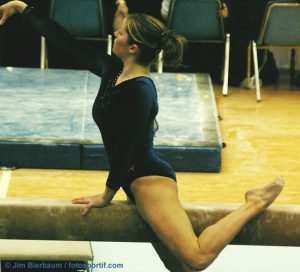
Please forgive me for not having posted in such a long time, but I’m going to try to make up for it in the coming weeks. To start off with, here is something I posted to my personal Facebook page (for all of my Facebook friend, few of whom are gymnastics fans at all) on February 5th, with just a few relatively minor edits. It’s pretty off the cuff and there are parts I would reword or add or delete if I took the time, but I think I should post as is and then work on new posts. It focuses on NCAA gymnastics as a great example of progress in women’s sports, & my opinion about collegiate gymnastics’ place within the larger sport of WAG.

Almost in time to be a day late, I wanted to mention that Wednesday, February 3, 2021 was the 35th annual Girls & Women in Sports Day, wonderfully commemorated by A Mighty Girl Facebook page. Recent years have seen women make significant strides in pro sports, such as getting increasing prize money and fighting for pay parity with the men in women’s sports like tennis & soccer. Then there’s the rise of viable women’s pro basketball and soccer leagues, and women entering the formerly men-only clubs of pro football & basketball coaching and officiating, and lots more.
But the most advancement has probably taken place at the collegiate level. Old-school chauvinists—the Frank DeFords of the sports journalism world—have loudly wailed and moaned for 35 years about how Title IX is stealing money from “real” sports like men’s football, or men’s basketball, or men’s baseball, or men’s badminton—pretty much men’s anything, and wasting those precious dollars on women’s sports that don’t matter to anyone & suck anyway. But women’s collegiate sport has blossomed and year after year continues to grow in popularity since the passage of Title IX, not to mention greatly increasing opportunities for athletic scholarships for women. Of course, the sport that I know the most about is gymnastics, so I will use it as an example of what women’s collegiate sports has to offer. Some of the things going for NCAA gymnastics are:
1) it’s a real, honest-to-goodness team sport, with the best six athletes for each apparatus (vault, bars, floor & beam) chosen from a roster of a more than a dozen, such that at any given meet it’s theoretically possible you might never see the same gymnast perform twice. The whole team loudly cheers on their teammate from right next to the apparatus, & afterward it’s hearty high fives (mostly air fives in the COVID-19 age, with by & large appropriate use of masks);
2) All the athletes are obviously having a lot of fun competing—there are more smiles in one rotation of college gymnastics than you’ll find in an entire elite competition (team, all-around, & individual apparatus). The competitors in NCAA WAG also live up to the term “women’s” gymnastics, fully grown, with hips & boobs & maybe even *gasp!* a little bit of body fat, unlike the high-strung, emaciated little zombies who inhabit elite gymnastics;
3) As the Olympics steadily whittles down the number of team members for each country (do you remember 1996’s “Magnificent Seven” who won gold in Atlanta? 2012’s Team USA was the “Fierce Five” & in Tokyo it will be the “Fortunate Four” or whatever they’re called—nicknames for Team USA are all the rage these days), the slimmer the chances of any gymnast to earn one of those spots. Thus, this steady narrowing of the chances of making the Olympic team has helped contribute to this next item;
4) Nowadays, most of the top elite gymnasts, including former US national team members & even Olympians go on to compete in NCAA instead of retiring when they either make the Olympic team or they don’t. This was not the case for the 1996 Mag 7, all of whom gave up their NCAA eligibility in order to cash in on the exhibition tours that followed their Atlanta gold (granted, some of them earned enough to pay for a college education several times over). The trend toward going to NCAA from elite is more & more becoming the norm (such that at a dual meet between, for example, UCLA & Alabama, you will see at least half a dozen former US national team members & an Olympian or two, plus a sprinkling of Olympians from other countries (there have been former national team members from UK, Canada, Australia, Venezuela, & others competing in the NCAA);
5) NCAA gymnastics is steadily growing in popularity with fans, both in person & on TV. Take the case of University of Utah — mind you, not all schools draw these sorts of numbers, but the Utes in 2019 averaged crowds of over 15,000 for all of their home meets. The top five fill up the same arenas where the basketball team plays, such that if the Ute’s women’s gymnastics team was a instead a men’s basketball team, they would be the 14th best draw in all of college basketball! Georgia, UCLA, Alabama, LSU, Oklahoma, Florida & other schools routinely fill their basketball arenas for home meets, it’s that fun & exciting to watch (& the crowds are as loud & rowdy as the athletes). And those fannies in the seats paid for their ticket. In the 2019 season the Utes WAG team brought in over $600,000 in ticket revenue for five home meets; and finally,


Leave a Reply